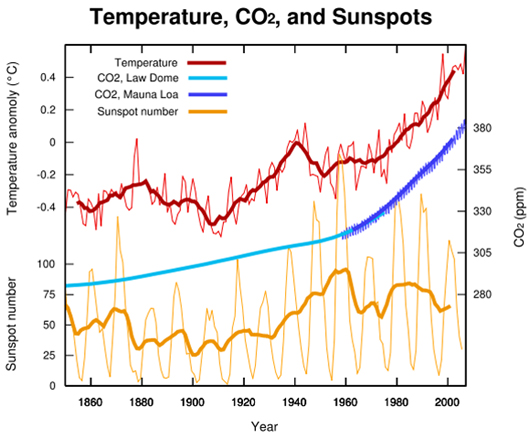Global Warming FAQs
To what extent does the Sun's variability affect and/or cause global climate change?
For decades, scientists have tried to understand the link between winds and
temperature and the Sun and its cycles. There were tell-tale signs of a connection.
For instance, the Little Ice Age recorded in Europe between 1550 and 1700 happened
during a time of very low solar activity.
Solar scientists have long known that solar variability changes
the distribution of energy in the Earth's atmosphere.
During the Sun's 11-year cycle, from solar maximum through solar minimum,
the energy released by the Sun changes by only about a tenth of a percent.
New studies have clarified that when the solar cycle
is at a maximum, it puts out a larger percentage of high-energy
radiation, which increases the amount of ozone in the upper atmosphere. The increased
ozone warms the upper atmosphere and the warm air affects winds all the way from the
stratosphere (that region of the atmosphere that extends from about 6 to 30 miles
high) to the Earth's surface. The change in wind strength and direction creates
different climate patterns around the globe.
However, according to Drew Shindell, a climate researcher from NASA's Goddard Institute for
Space Studies in New York, NY,
the most recent studies have confirmed that changing levels of energy from
the Sun are not significant enough to be a major cause of global warming:
"...the solar increases do not have the ability to cause large global temperature
increases...greenhouse gases are indeed playing the dominant role..." The Sun is once
again less bright as we approach solar minimum, yet global warming continues."
For more details, see
Link Between Solar Cycle and Climate is Blowin' in the Wind
You might also like to read the paper
Solar Irradiance Since 1874 Revisited
by S. K. Solanki and M. Fligge, Geophysical Research Letters, vol. 25, no. 3,
pages 341-344 (1 Feb 1998)

Were changes on the Sun, the Maunder Minimum, related to the Little
Ice Age in Europe?
A NASA computer climate model reinforces the long-standing theory that low solar
activity could have changed the atmospheric circulation in the Northern Hemisphere from the
1400s to the 1700s and triggered a "Little Ice Age" in several regions including North
America and Europe. Changes in the Sun's energy was one of the biggest factors influencing
climate change during this period, but have since been superceded by greenhouse gases due to
the industrial revolution.
See
The Sun's Chilly Impact on Earth

